Jaarboek voor Nederlandse Boekgeschiedenis. Jaargang 16
(2009)– [tijdschrift] Jaarboek voor Nederlandse Boekgeschiedenis–
[pagina 199]
| |
Kathryn M. Rudy
| |
[pagina 200]
| |
The miniatures in the Trivulzio Hours were made by three different artists: Simon Marmion from Valenciennes; the Vienna Master of Mary of Burgundy, who presumably worked in Ghent; and Lieven van Lathem, who started out in Ghent, but then spent time in the Northern Netherlands before settling in Antwerp. The Vienna Master of Mary of Burgundy is the name of convenience given to the artist whose hand can be seen in his miniatures in Vienna, Österreichische Nationalbibliothek, Ms. 1857.Ga naar voetnoot5 Besides the Trivulzio Hours, the Vienna Master of Mary of Burgundy and Lieven van Lathem worked together on other manuscripts, including the Prayer Book for Charles the Bold, even though they did not live in the same city. In the Trivulzio Hours, Lieven van Lathem probably had the lead role, choreographing the iconographic program as well as executing much of it.Ga naar voetnoot6 To find sources for the imagery for some of the miniatures in the Trivulzio Hours, the miniaturists went beyond manuscript models and used painted altarpieces as sources for their figures and compositions. For other miniatures, Lieven van Lathem depicted contemporary liturgical celebrations, thereby using religious practice as a visual source. Specifically, he depicts the stages of the mass taking place at various altars. This decision to base the iconography upon their contemporary visual environment - which also included painted images such as altarpieces - rather than to depend wholly on manuscript models, represents a stark departure from how illuminators had previously conceptualized the process of creation. This article considers, primarily, the contribution of Lieven van Lathem, as well as the one miniature painted by the Vienna Master of Mary of Burgundy, the two artists who were responsible for painting the full-page miniatures that preface the Hours and Masses of the days of the week. These two artists also had the closest ties to Ghent. Van Lathem was born in or around Ghent in 1438 to a family of artists.Ga naar voetnoot7 He worked as an artist at the court of Duke Philip the Good beginning in 1456 when he was 18 years old. After a conflict he had shortly thereafter, he left Ghent, and probably spent the years between 1457 and 1462 in Utrecht, a major production center for manuscript illumination in the north, where he worked with the Master of Catherine of Cleves.Ga naar voetnoot8 He then | |
[pagina 201]
| |
moved to Antwerp, where we find his name in the membership lists of the Guild of St. Luke for the year 1462. He lived there until his death in 1493. While he was based in Antwerp, his work took him to other cities in the Southern Netherlands, where he was in contact with other artists and potential patrons. In 1468 he was one of the more than 166 artists who labored on the ceremonial decorations for the meeting of the Chapter of the Order of the Golden Fleece and the wedding of Charles the Bold and Margaret of York, which took place in July 1468. In that same year Lieven van Lathem also contributed many miniatures to a prayer book for Charles the Bold (now Los Angeles, Getty Museum, ms. 37), to which the Trivulzio Hours is related.Ga naar voetnoot9 During these years of travel and work, Lieven van Lathem must have continuously studied panel paintings he encountered, and he, probably more than any other illuminator, imbued his miniatures with compositions from panel paintings he absorbed during his travels.Ga naar voetnoot10
My conclusions in this article are speculative, but I lay them out here from the outset: Lieven van Lathem invented a spectacular new solution to the daunting task of producing 14 miniatures for the relatively infrequently copied Hours and Masses for the days of the week. His solution was to depict the relevant liturgical celebrations, thereby turning liturgy into an object of representation. The rhythm of the weekly liturgies thereby echoes the rhythm of the weekly readings. The liturgical celebrations do no seem to take place in one unified and coherent church, but rather, Lieven van Lathem depicted various altars within a fantasy Gothic church, which in some ways resembles the Sint-Janskerk in Ghent. (The name of the church was changed to the Cathedral of St. Bavo [the Sint-Baafskatedraal], but it will be called Sint-Janskerk in this article.) At least | |
[pagina 202]
| |
one of the miniatures in the Trivulzio Hours clearly recalls an altarpiece in the Sint-Janskerk, namely a post-card-sized rendition of the Ghent Altarpiece. Studying his miniatures not only gives us insight into a new source for imagery, but also gives us insight into the reception of the Ghent Altarpiece in the fifteenth century. While the miniatures for the daily masses take liturgical celebrations as their subjects, the miniatures for the daily hours largely borrow motifs from painted altarpieces. In re-inventing altarpieces and altars within the decorative program of the manuscript, the illuminators have constructed a massive church in a minute book; they have coordinated the miniatures with the space and liturgy; and they have recreated a weeklong liturgical cycle by means of a series of illuminations recalling ecclesiastical interiors. They have made their presumed patron not a witness to the events of sacred history, but to the daily performance of the mass. In doing so the miniaturists have created a virtual tour of a Gothic church, which unfolds in the daily visits to its altars. | |
Lieven van Lathem's miniature and Jan van Eyck's altarpieceThe Hours for each day of the week, grouped together with the Masses for each day of the week, appear in a minority of Flemish prayer books, primarily those made for nobles and those commissioning the most luxurious books. This combination of texts appears, for example, in an exquisite Book of Hours that may have been commissioned around 1465-1470 by a high functionary of the Sint-Pieterskerk in Ghent (Amsterdam, ub, xxv c 26, fol. 25r). It was once thought that Lieven van Lathem formed part of the team of illuminators who painted the miniatures in this manuscript, although that idea has now been discredited.Ga naar voetnoot11 The lead artist, the Master of Gerard Brilis, however, knew Lieven van Lathem, and the two illuminators had worked on the Sachsenheim Hours (Stuttgart, Württembergisches Landesbibliothek, Cod. 162) around 1455-1460. Although Lieven van Lathem may have known of the Hours of the Sint-Pieterskerk, he made quite different choices for subjects to preface the daily Hours and Masses. For the Hours of All Saints, the illuminator of Amsterdam, ub, xxv c 26 selected an image depicting the Virgin and Child sitting in a landscape (colour illustration 1). Lieven van Lathem rejected this solution, possibly because the Virgin and Child simply did not embody the concept of ‘All Saints’, and he created a more appropriate image for the incipit of the same text in the Trivulzio Hours. For his image to accompany the Wednesday Hours of All Saints in the Trivulzio Hours (colour illustration 2), Lieven van Lathem turned instead to one of the most | |
[pagina 203]
| |
important altarpieces of his hometown, the Adoration of the Mystic Lamb - also known as the Ghent Altarpiece - which was painted in 1432 by Jan van Eyck, possibly together with his brother Hubert (colour illustration 3).Ga naar voetnoot12 While the altarpiece is gigantic, filling the width of an entire chapel situated in the ambulatory of the great Sint-Janskerk, the miniaturist performs a feat by shrinking the composition into a frame only 85 × 50 mm in size. The Adoration of the Mystic Lamb must have been one of the most impressive visual statements in the Southern Netherlands in the mid-fifteenth century. And it would have been the boldest image of All Saints available to Lieven van Lathem as a source for his miniature. The polyptych encompasses panels with isolated images as well as scenes spread across multiple panels. Part of the exterior of the panels is executed in grisaille, a technique that resembles the illusionist depiction of stone.Ga naar voetnoot13 In addition to a large rendering of the Annunciation set in a domestic interior, the exterior wings also contain the portraits of the patrons, Jodocus Vijd and his wife Elisabeth Borluut. When they commissioned the altarpiece, they also commissioned a place to display it, namely the first radiating chapel on the south side of the choir in the Sint-Janskerk, which was dedicated to All Saints, although the chapel was not completed by the time the altarpiece was finished. Opening the wings of the altarpiece reveals a panoramic landscape painted in intense saturated colors, depicting the saints in a heavenly paradise proceeding on foot to an altar represented at the center of the central panel. On this altar stands the Lamb of God. Red blood pours from the lamb's open wound into a chalice below. The bleeding lamb is arranged on a vertical axis that also bisects the fountain of life, an octagonal fountain whose waters irrigate the verdant paradise. The saints approach the altar in groups from the left and right, to converge at the vertical axis marked by the lamb, the altar, and the fountain. The saints include Just Judges and the Soldiers of Christ (Christi Milites) on the left wings, Old Testament fathers in the left foreground, martyred clergymen at the left background, apostles, bishops and popes at the right foreground, virgins behind them on the right, and hermits and pilgrims filling the right wings. It is this colorful open state that inspired Lieven van Lathem's miniature. The polyptych's interior, after all, depicts throngs of saints coming to worship the sacrificial lamb on the altar, a concept that embodies the Mass as well as the iconographic program in the first section of the Trivulzio Hours. In the course of transforming the immense and densely populated group of panels into a tiny miniature, from a behemoth scale to one that is smaller than a post-card, Lieven van Lathem has made some necessary adjustments to the composition. He had to severely reduce the number of figures. To accomplish this, the artist has let a single saint in the miniature stand as a proxy for a whole category of saints in the altarpiece. For example, the three saints at the left foreground in the miniature are a cardinal, a pope, and a bishop, as identified by their headgear. They stand for all the cardinals, | |
[pagina 204]
| |
popes, and bishops in the altarpiece, who approach the altar in Van Eyck's painting from the left background. Lieven van Lathem has foregrounded them, but to make room for them, he has simply erased the throng of Old Testament prophets and fathers depicted in Van Eyck's altarpiece. To help to establish the identities of the saints on such a small scale, Van Lathem has given them minute attributes. The cardinal has a lion at his side, identifying him as St. Jerome, and the bishop's deer identifies him as St. Hubert. Likewise, Van Lathem places two hermits at the right foreground, St. Anthony, recognizable by the pig trampling the hem of his robe, and another saint, probably St. Paul, the first hermit. Anthony had visited Paul in his hermitage, a scene that appears in the miniature. These two stand as proxies for the large group of hermits making their way over the desiccated and rocky ground on the right wing of Van Eyck's panel. With their grey beards and forelocks of grey on otherwise balding domes, Van Lathem tries to reiterate the aged and unshorn quality of the saints in the source image. The group of pilgrims on the far right panel of the Ghent Altarpiece is also severely reduced in Lieven van Lathem's miniature: the giant St. Christopher, who steps gingerly through Van Eyck's fictive paradise, stands as a proxy for all pilgrims in the miniature. He appears in the distant middleground of the miniature, crossing the river with the Christ child on his shoulders, just under the Lamb of God. Whereas the giant dominates the right foreground of Van Eyck's open polyptych, he is reduced to the size of a flea in the miniature, visible only to the alert. In the miniature, the confessors approach from the hills on the left, the virgins, led by St. Catherine, march from the right, and the soldiers of Christ, including St. George with his recognizable armor, approach from the rear, but neither the Old Testament fathers and prophets, nor the Just Judges, have made it into Lieven van Lathem's miniature world. Lieven van Lathem has simply omitted all the groups in Van Eyck's crowded paradise that predated the era of Christianity. The miniaturist changed not only the scale, but also the proportions of the image. Whereas Jan van Eyck depicted the expanse of paradise stretching across five panels, Lieven van Lathem had to translate that width into depth. Whereas Jan van Eyck employed a clean central axis, Lieven van Lathem squashed space so that the central axis zig-zags, accordion-like, from the foreground to the background in the hazy blue distance. As in a crowded urban environment, the solution to finding more space is to build upward. Lieven van Lathem, likewise, has elevated the Lamb of God onto a high cross, which bisects the flowing river in the background that irrigates the distant miles of paradise. In abbreviated fashion Lieven van Lathem has suggested that the river also flows toward the foreground by having the soldiers march through a valley that may be read as a riverbed: the grey horse, as well as the saints' attributes - lion, deer, and pig - strain as if to drink the water. | |
[pagina 205]
| |
The context of the Adoration of the Mystic Lamb in the Trivulzio HoursThe Adoration of the Mystic Lamb is the keystone to Lieven van Lathem's iconographic theme. Jan van Eyck's polyptych envisions a lush paradise in which figures from sacred and secular history come from all cardinal directions to pay homage to the Lamb of God, which stands on an altar of sacrifice. They carry out an idealized mass, witnessed by the elect. As they carry out this sacrificial offering, they are overshadowed by a figure who is both God the Father and Jesus, along with Mary and John the Baptist, in the upper register. The mass is also framed by Gothic church towers on the horizon, which anchor the mystical mass to the contemporary ecclesiastical environment. Represented angels cense the fictive altar, just as real acolytes would cense the altar and altarpiece in the Sint-Janskerk. Lieven van Lathem's quotation of the Ghent Altarpiece should be seen in the context of the miniatures prefacing the Hours and Masses for each day of the week. The illuminator met the challenge of producing new iconography for these texts by representing altarpieces and the activities that take place at altars. For some of the miniatures, he repeated variations on a compositional formula established by some standard subjects, such as Pentecost and the Mass of St. Gregory, which were normally represented in church interiors. Lieven van Lathem went on to produce variations on these themes by painting masses taking place at distinctive altars during different moments of the ecclesiastical performance. Moreover, he represented a selection of altars within a relatively coherent ecclesiastical interior, a Gothic church with a long nave, a choir with choir stalls, side chapels along the aisles, and radiating chapels in the ambulatory. In fact, the ecclesiastical interiors in the Trivulzio Hours, taken cumulatively, resemble the Sint-Janskerk in Ghent. The miniatures should not, however, be seen as a variety of mimetic views within that church, since they vary in their depictions of ornament and details. We should also remember that when Lieven van Lathem painted these interiors, he no longer lived in Ghent, so the Sint-Janskerk may not have been a convenient model for him.Ga naar voetnoot14 We should consider the miniatures in the Hours and Masses section of the manuscript (fols. 13v-127v) in pairs, that is, the pair of miniatures accompanying the Sunday Mass and Hours, the pair for the Monday Mass and Hours, and so forth. What follows here is an analysis of each pair. The first two images are for Sunday's Hours and Mass. For the Hours of the Trinity, Lieven van Lathem presents an unusual depiction of the Trinity: God the Father sitting in a throne with the Holy Spirit in the form of a large angel, as they hold up the dead and naked Christ (fol. 13v; colour illustration 4). This depiction of the Trinity may have derived from a panel painting or a polychromed sculpture group in a setting with a gilt | |
[pagina 206]
| |
Gothic tracery canopy.Ga naar voetnoot15 The image prefacing the Sunday Mass for the Trinity presents a mass taking place at an altar, which is situated at one of the columns in the nave of the church (fol. 22v; colour illustration 5). Like many of the other altars represented by Lieven van Lathem, as we will see, this one has curtains, which have been opened during the mass.Ga naar voetnoot16 The altarpiece is not visible from our sharp angle of view. We are, however, privy to the canopy and sculpture that surmounts the altarpiece, which represents the Trinity. Lieven van Lathem has therefore provided two views of the same subject, one which is fully revealed, and one which is concealed, for the second Trinity is given at a sharply oblique angle, which reveals the altar but not the altarpiece. Above the level of the green curtain, which would have concealed and revealed the lower part of the altarpiece, is a representation of a sculpture group depicting the Trinity under a gilt Gothic tracery canopy. The miniature for the Monday Mass of the Dead is missing (it would have prefaced fol. 40), and the miniature for the Hours of the Dead depicts a burial outside a church (colour illustration 6). This subject is commonly used to preface the Vigil for the Dead in other manuscripts. Lieven van Lathem's miniature represents the exterior of a Gothic church, set in an urban environment. The Tuesday Hours of the Holy Spirit is prefaced by a miniature depicting the descent of the Holy Spirit - Pentecost - in a Gothic church interior (fol. 44v; colour illustration 7). Lieven van Lathem specifies the location as the high altar, which is separated from the nave of the church with a rood screen. He delineates the Gothic nave, with its compound piers and clerestory windows, as well as the transept and a carved wooden rood screen with Gothic tracery. The building he has depicted, however, is incomplete, and the unfinished walls give way to a city view.Ga naar voetnoot17 The miniature for the Tuesday Mass of the Holy Spirit seems to take place at the high altar, as well, but this time appears from a different angle and includes the depiction of some choir stalls (fol. 52v; colour illustration 8). We can see that Lieven van Lathem may be developing a pattern, namely, an interest in showing a single altar from two different perspectives for the daily Hours and the corresponding Mass. The miniatures for Wednesday thematize All Saints. The Wednesday Hours for All | |
[pagina 207]
| |
Saints is prefaced by the miniature interpretation of the Ghent Altarpiece (as discussed above) (fol. 59v; colour illustration 9). The second image, prefacing the Wednesday Mass for All Saints, takes place in a cramped space that may be interpreted as a chapel within a church (fol. 67v; colour illustration 10). Lieven van Lathem has demonstrated that the chapel is dedicated to All Saints by cramming 17 saints into the back of the chapel. The chapel could be likened to the Vijd-Borluut chapel in the Sint-Janskerk. The Vijd-Borluut chapel, which was the first chapel east of the transept, situated just to the south of the high altar, was also dedicated to All Saints. In the same way that Lieven van Lathem transformed the altarpiece into a miniature by adjusting the scale, orientation, and composition to suit the demands of the medium, perhaps he was also evoking the Vijd-Borluut chapel in the Sint-Janskerk in this miniature, straying from mimesis to capture the spirit of the place. If so, then the artist provided two views of this chapel to preface the two special texts for Wednesday's celebration of All Saints. The first view is the interpretation of the shrunken altarpiece itself, in its full color but abbreviated composition. The second view shows us a mass taking place in a chapel dedicated to All Saints and in the presence contemporary witnesses. The two miniatures for the Thursday Hours of the Sacrament and Mass of the Sacrament likewise give us two views of an altar dedicated to the sacrament. In both miniatures the altarpiece bears a depiction of the Crucifixion and is surmounted by two angels presenting a chalice. In the first miniature - for the Thursday Hours of the Sacrament - the priest holds a monstrance containing the Eucharist. Behind him is an altarpiece with Christ on the Cross between Mary and John, which is surmounted by a sculpture depicting angels presenting a monstrance similar to the one the priest is holding (fol. 76v; colour illustration 11). Dominating the image is a Eucharist tower, carved in stone and rising all the way to the ceiling.Ga naar voetnoot18 Eucharist towers were built for housing, protecting, and glorifying the sanctified host. The piece of micro-architecture in Lieven van Lathem's miniature resembles the Eucharist tower that is still to be seen in the Sint-Pieterskerk in Leuven (figure 1). Other churches throughout the Southern Netherlands undoubtedly possessed similar Eucharist towers, but they have survived in small numbers, because iconoclasts targeted them in the sixteenth century.Ga naar voetnoot19 The related miniature prefacing the Thursday Mass of the Sacrament depicts an altar from a different angle (fol. 86v; colour illustration 12). This time we see the choir stalls on the north side of the choir. The liturgy has also moved on, as here we see a different moment of the mass, the moment at which the priest elevates the Eucharist. Two lay bystanders, shut out from the physical space, peer through the screen, possibly in an attempt to participate in ocular communion.Ga naar voetnoot20 The miniature for the Friday Hours of the Cross depicts the Crucifixion on Mt. Calvary, and was supplied not by Lieven van Lathem, but by the Vienna Master of Mary of Burgundy (colour illustration 13). Just as the All Saints miniature can be seen as a reinterpretation of the Ghent Altarpiece, this miniature may be a re-interpretation of the | |
[pagina 208]
| |
Calvary triptych painted by Joos van Ghent (also known as Joos van Wassenhove), a painting that can still be seen in the Cathedral of St. Bavo (Sint-Janskerk) in Ghent today (colour illustration 14). Joos van Ghent came from Antwerp, where he was listed among the members of the painters' guild in 1460, before moving to Ghent. He matriculated in the Ghent painters' guild on 6 October 1464 and shortly thereafter painted 40 escutcheons for the Sint-Janskerk. Around this time he also completed the Calvary triptych. In 1465 he moved to Italy, where he executed a series depicting the Communion of the Apostles for Frederick of Montefeltro between 1465 and 1474. The painter's departure from Ghent in 1465 therefore marks a terminus ante quem for the Calvary triptych. Laureins de Maech (d. 6 March 1469) and his wife Louise van den Hove (d. 31 December 1483) probably commissioned the painting, and installed it in their own chapel, which they dedicated around 1462.Ga naar voetnoot21 (See figure 2 for a ground plan of the Sint-Janskerk. The De Maech chapel may have been chapel vi or ix. The chapel dedicated to All Saints with Jan van Eyck's polyptych is xiii.) 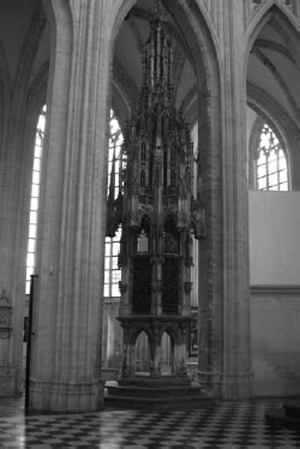 Figure 1: Eucharist tower, Leuven, Sint-Peterskerk, 15th century. Photo: Author
| |
[pagina 209]
| |
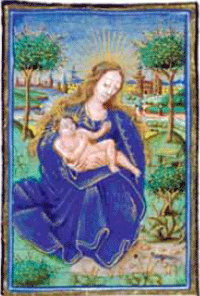 Colour illustration 1: Virgin and Child in a Landscape.
Column miniature for the Hours of All Saints. Amsterdam ub, Ms. xxv C 26, fol. 251. Miniature 60 × 40 mm | |
[pagina 210]
| |
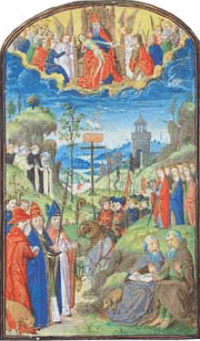 Colour illustration 2: Lieven van Lathem, Saints convening at the Agnes Dei in a landscape. Miniature for the Wednesday Hours of All Saints, The Hague, kb smc 1, fol. 59v, detail. Miniature 85 × 50 mm
| |
[pagina 211]
| |
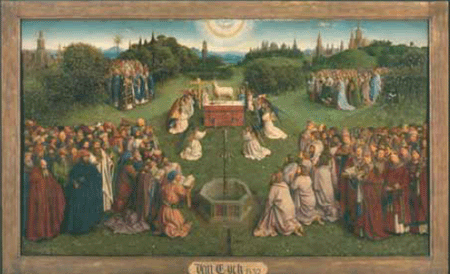 Colour illustration 3a: Jan van Eyck, Adoration of the Mystic Lamb (The Ghent Altarpiece), open state, 350 × 461 cm. 1432. Ghent, Cathedral of St Bavo (formerly called Sint-Janskerk)
| |
[pagina 212]
| |
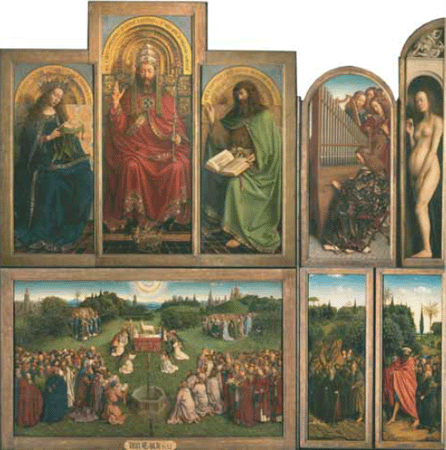 Colour illustration 3b: Jan van Eyck, Adoration of the Mystic Lamb (The Ghent Altarpiece), open state, 350 × 461 cm. 1432. Ghent, Cathedral of St Bavo (formerly called Sint-Janskerk)
| |
[pagina 213]
| |
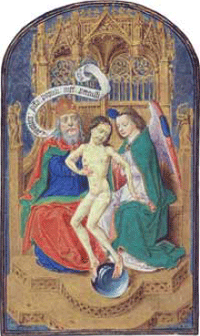 Colour illustration 4: Lieven van Lathem, Trinity enthroned. Miniature for the Sunday Hours of the Trinity, The Hague, kb smc 1, fol. 13v.
Miniature 84 × 50 mm 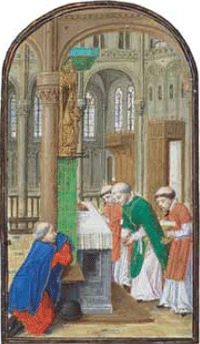 Colour illustration 5: Lieven van Lathem, A priest and two acolytes blessing of the altar, in the presence of a cleric. Miniature for the Sunday Mass for the Trinity, The Hague, kb smc 1, fol. 22v. Miniature 84 × 50 mm
| |
[pagina 214]
| |
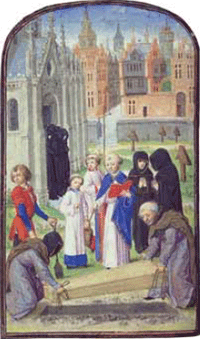 Colour illustration 6: Lieven van Lathem, Burial outside a church. Miniature for the Monday Hours of the Dead, The Hague, kb smc 1, fol. 30v. Miniature 85 × 50 mm
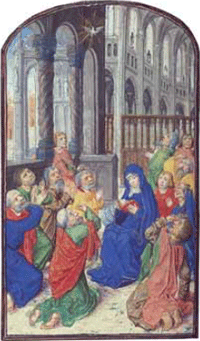 Colour illustration 7: Lieven van Lathem, Pentecost. Miniature for the Tuesday Hours of the Holy Spirit, The Hague, kb smc 1, fol. 44v. Miniature 84 × 50 mm
| |
[pagina 215]
| |
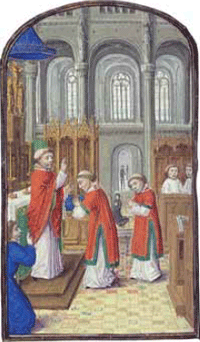 Colour illustration 8: Lieven van Lathem, Priest blessing the high altar. Miniature for the Tuesday Mass of the Holy Spirit, The Hague, kb smc 1, fol. 52v. Miniature 84 × 50 mm
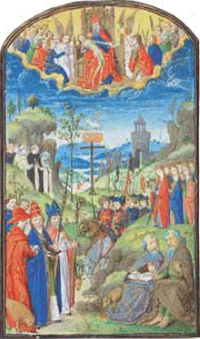 Colour illustration 9: Lieven van Lathem, Saints convening at the Agnes Dei in a landscape. Miniature for the Wednesday Hours of All Saints, The Hague, kb smc 1, fol. 59v, detail. Miniature 85 × 50 mm.
| |
[pagina 216]
| |
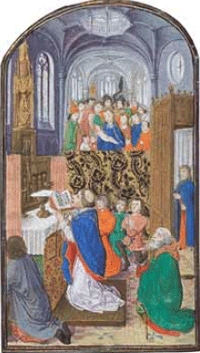 Colour illustration 10: Lieven van Lathem, Offertory at an altar in a chapel dedicated to All Saints. Miniature for the Wednesday Mass for All Saints, The Hague, kb smc 1, fol. 67v. Miniature 85 × 50 mm.
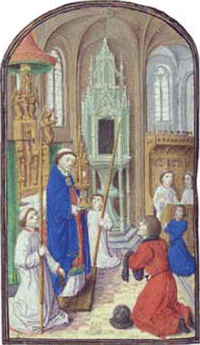 Colour illustration 11: Lieven van Lathem, the host being displayed in an ostensorium at the High Altar. Miniature for the Thursday Hours of the Sacrament, The Hague, kb smc 1, fol. 76v. Miniature 85 × 50 mm
| |
[pagina 217]
| |
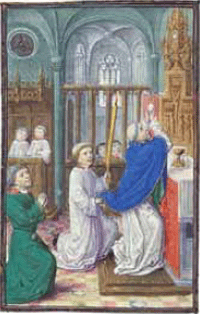 Colour illustration 12: Lieven van Lathem, Raising of the Eucharist at the High Altar. Miniature for the Thursday Mass of the Sacrament, The Hague, kb smc 1, fol. 86v. Miniature 67 × 42 mm.
 Colour illustration 13: Vienna Master of Mary of Burgundy, Crucifixion on Mt. Calvary. Miniature for the Friday Hours of the Cross, The Hague, kb smc 1, fol. 94v. Miniature 70 × 48 mm
| |
[pagina 218]
| |
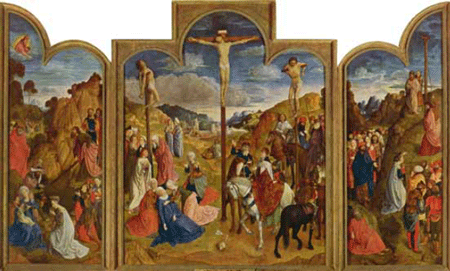 Colour illustration 14: Joos van Ghent (as Joos van Wassenhove), Calvary triptych, before 1465. 250 × 216 cm. Ghent, Cathedral of St Bavo (formerly called Sint-Janskerk)
| |
[pagina 219]
| |
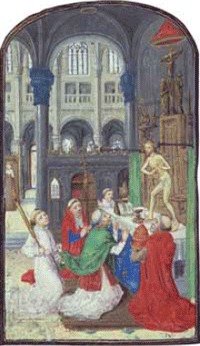 Colour illustration 15: Lieven van Lathem, the Mass of St. Gregory. Miniature for the Friday Hours of the Cross, The Hague, kb smc 1, fol. 103v. Miniature 85 × 50 mm
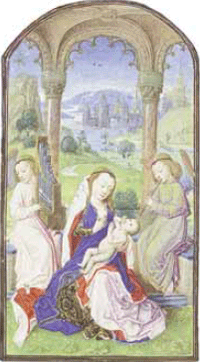 Colour illustration 16: Lieven van Lathem, Maria lactans with music-making angels. Miniature for the Saturday Hours of the Virgin, The Hague, kb smc 1, fol. 110v. Miniature 80 × 45 mm
| |
[pagina 220]
| |
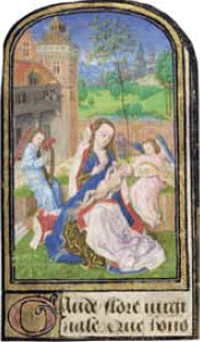 Colour illustration 17: Lieven van Lathem, Maria lactans with music-making angels. Column-wide miniature for a prayer to the joys of the Virgin, the Prayer Book of Charles the Bold, The J. Paul Getty Museum, Los Angeles, Ms. 37, fol. 10r. Tempera colors, gold leaf, gold paint, silver paint, and ink on parchment, 1469. Leaf: 121 × 90. Miniature: 65 × 39 mm
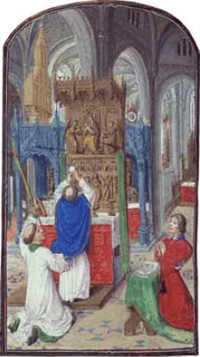 Colour illustration 18: Lieven van Lathem, The Raising of the Host at the Altar of the Virgin. Miniature for the Saturday Mass of the Virgin, The Hague, kb smc 1, fol. 120v. Miniature 85 × 50 mm
| |
[pagina 221]
| |
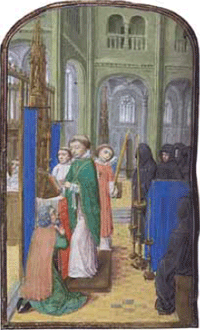 Colour illustration 19: Lieven van Lathem, the Mass for the Dead. Miniature for the Office of the Dead, The Hague, kb smc 1, fol. 271v. Miniature 80 × 50 mm
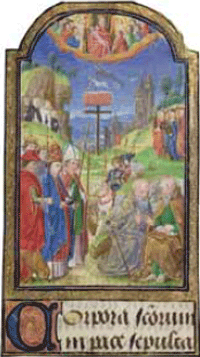 Colour illustration 20: Lieven van Lathem, Saints convening at the Agnes Dei in a landscape. Column-wide miniature for a prayer to All Saints, in the Prayer Book of Charles the Bold, The J. Paul Getty Museum, Los Angeles, Ms. 37, fol. 43r. Tempera colors, gold leaf, gold paint, silver paint, and ink on parchment, 1469. Leaf: 121 × 90. Miniature: 62 × 37 mm
| |
[pagina 222]
| |
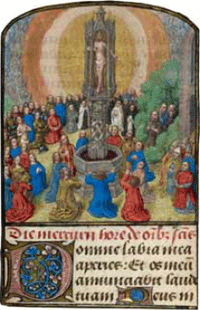 Colour illustration 21: Anonymous miniaturist working in the circle of the Vienna Master of Mary of Burgundy, All Saints Gathered at the Fountain of Paradise.
Miniature for the Hours of All Saints, London, British Library, Add. ms 17026, fol. 33r. Published with permission from the British Library 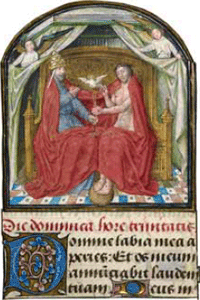 Colour illustration 22: Anonymous miniaturist working in the circle of the Vienna Master of Mary of Burgundy, Trinity revealed by angels. Miniature for the Hours of the Trinity, London, British Library, Add. ms 17026, fol. 16r. Published with permission from the British Library
| |
[pagina 223]
| |
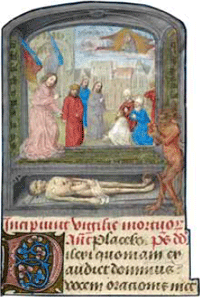 Colour illustration 23: Anonymous miniaturist working in the circle of the Vienna Master of Mary of Burgundy, The Raising of Lazarus. Miniature for the Vigil of the Dead, London, British Library, Add. ms 17026, fol. 152r. Published with permission from the British Library
| |
[pagina 224]
| |
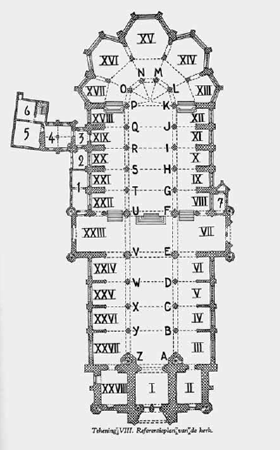 Figure 2: Plan of the Sint-Janskerk. Taken from E. Dhanens, Sint-Baafskathedraal Gent (Ghent: Bestendige Deputatie van de Provinciale Raad van Oostvlaanderen, 1965), 55
The relationship between the miniature depicting the Crucifixion and altarpiece by Joos van Ghent must remain tentative, however. While the altarpiece represents many figures and bustling activity on Calvary, the miniaturist severely reduces the number of figures. If the miniaturist has used the altarpiece as a source, then he, like Lieven van Lathem in re-interpreting the Ghent Altarpiece, had to change the proportions from a horizontal format to a vertical one. There are however similarities in the handling of paint and in details of the composition between the miniature and Joos van Ghent's triptych. As Thom Kren writes, ‘[T]he magnificent Crucifixion [in the Trivulzio Hours] echoes The Crucifixion in the Calvary triptych of Joos van Ghent in many ways: the swooning Virgin, her arms limp; the writhing figures on the cross; the facial types, such as the man with the bifurcated white beard in the left foreground; and the brooding sky.’Ga naar voetnoot22 It is possible that the Vienna Master made a conscious decision to construct this | |
[pagina 225]
| |
miniature inspired by the altarpiece within the Sint-Janskerk. Unlike the All Saints miniature, which is highly unusual and bears a strong resemblance to Jan van Eyck's altarpiece, the Crucifixion was simply a much more common subject, and establishing the relationship between the miniature and the triptych relies on a stylistic similarity. Whether the patron of the Trivulzio Hours recognized the triptych in his miniature remains an open question. The pattern of representing one altar twice for each day of the week continues in the miniature for the Friday Hours of the Cross (fol. 103v; colour illustration 15). If the Vienna Master depicts the altarpiece fully frontal, then Lieven van Lathem depicts a mass taking place at an altar at a sharp oblique angle. Specifically, for the image prefacing the Friday Mass of the Cross, Lieven van Lathem has provided a miniature depicting the transubstantiation of the host at the Mass of St. Gregory (fol. 103v). The artist sets the event in one of the chapels in the south ambulatory of a Gothic church. He has represented a slice of the church, viewed from within the chapel while looking across the choir. We can make out one tonsured monk singing in the last choir stall. Beyond the choir is the north side of the ambulatory, with its chapels mirroring the one in which Lieven van Lathem has placed us. In keeping with the pattern he has been establishing in these miniatures, the artist provides one iconic and fully frontal image that may derive from a painted triptych, followed by an oblique view of an altarpiece, which sets the altar in its ecclesiastical setting. The Mass of St. Gregory was frequently depicted in Netherlandish miniatures, nearly always at an altar inside a church. However, the image was most commonly associated with another text, namely, the Verses of St. Gregory, one of the most generously indulgenced texts of the late middle ages. As if to allude to the high value of the indulgences associated with the image of the Mass of St. Gregory, Lieven van Lathem has depicted a framed tablet hanging on the inside of the chapel wall. Such tablets were associated with the promulgation of indulgences. To earn the indulgences connected to the Verses of St. Gregory, the votary was usually required to recite the text in the presence of an image of Christ as Man of Sorrows, or the arma Christi. The reason for this had to do with the origin myth surrounding the Verses of St. Gregory, which relates how St. Gregory, then pope, was conducting mass. To allay doubt that the Eucharist was the equivalent of the body of Christ, Christ himself appeared to those present at the mass and revealed his wounds, just at the moment when Gregory was elevating the Eucharist. The story, with its accompanying image, therefore concretizes the Transubstantiation, the doctrine that the body of Christ is present in the Eucharist wafer. Instead of depicting an altarpiece with the body of Christ hanging from a cross, Lieven van Lathem has shown us the body of Christ stepping onto the altar, with the instruments of the Passion represented on the altarpiece behind him. St. Gregory holds his hands up in astonishment as he reacts to the bleeding body of Christ, which has just appeared physically before his eyes. As with his other miniatures in this series, Lieven van Lathem reiterates the theme of the altar in the sculpted group that surmounts the triptych, in this case, a Crucifixion. Lieven van Lathem paints only generalized monotone altarpieces for each of the | |
[pagina 226]
| |
masses. For the Friday Mass of the Cross, Lieven van Lathem shows this generalized altarpiece from a slightly bird's-eye perspective, which also allows him to depict a deep view across the east end of the church. In sum, Lieven van Lathem has recontextualized the Mass of St. Gregory, removing the image from its more common textual association with the Verses of St. Gregory, and assigning it instead to the Friday Mass of the Cross, for which there was no standard iconography. To preface the Saturday Hours of the Virgin, the artist gives us an image of Maria lactans with music-making angels (110v; colour illustration 16). This miniature is probably based on a painted altarpiece by Dirck Bouts, which existed in several copies, one of which is now preserved at the Capilla Real in Grenada.Ga naar voetnoot23 Although it is impossible to be certain, we might hypothesize that Lieven van Lathem's miniature not only takes a Marian altarpiece as its model, but actually re-presents the altarpiece so that the miniature would have reminded the manuscript's owner of the painted panel. Perhaps Charles the Bold also recognized it as a motif from a panel painting, as a copy also appears in his Prayer Book (colour illustration 17). The second image for Saturday, which prefaces the Saturday Mass of the Virgin, gives us one of the fullest and most visually rich views of the church interior (120v; colour illustration 18). In this miniature, Lieven van Lathem shows us an altar situated at a column in the nave. The altar is dedicated, appropriately, to the Virgin, who appears in a sculpture under the carved canopy in her guise as the Virgin of Pity, with her dead son on her lap. Although our spatial position is not completely clear in this image, we are probably in the south aisle, looking north-east toward the choir. Lieven van Lathem shows us a Gothic church crammed with altars, where every column and pier provides a structure at which to perform the liturgy. In total, we can see parts of six different altars or micro-architectural structures within this ecclesiastical interior.Ga naar voetnoot24 It has been said that Lieven van Lathem depicts the stages of the mass in this series of miniatures, and to some degree, that is true.Ga naar voetnoot25 The image for the Sunday Mass for the Trinity (fol. 22v), for example, represents the beginning of the ceremony, with the priest approaching the altar, while subsequent miniatures show the blessing, the elevation of the host, and the transfiguration. What is even more ingenious, however, is that the illuminator has assigned the various stages of the mass to the appropriate theme of the day. The image for the Sunday Mass for the Trinity shows three clerics - a priest and two acolytes - bowing to the altar, in recognition of the Trinity. The Tuesday Mass for the Holy Spirit (fol. 52v) depicts the blessing, the part of the ceremony that is to summon the Holy Spirit to the altar. The Wednesday Mass for All Saints shows the Offertory, the offering of the gifts on the altar; these gifts may include the saints' martyrdoms (fol. | |
[pagina 227]
| |
67v). The Thursday Hours of the Eucharist (fol. 76v) depicts the host being displayed in an ostensorium, while the related Thursday Mass (fol. 86v) shows the Elevation of the Host. The Friday Mass of the Cross (fol. 103v) presents the transfiguration in the context of the Mass of St. Gregory, at which the cross is present among the other arma Christi. The Saturday Mass of the Virgin, finally, depicts the Elevation of the Host again, this time in the presence of the Virgin's image. The elevation of the host is therefore repeated in several relevant contexts. While the artist has indeed presented the stages of the mass in roughly chronological order, he has done so in a manner that distributes the most dramatic moments over the seven days of the week so that each daily mass features one relevant moment keyed to the liturgy. This series of miniatures sometimes zooms in to examine a particular altarpiece, and sometimes zooms out to give us long views of contiguous spaces within a Gothic church interior. We cannot say with certainty whether Lieven van Lathem and the Vienna Master of Mary of Burgundy were responding to the interior of the Sint-Janskerk. At the very least, Lieven van Lathem drew inspiration from the specific moments in the performance of the liturgy, as it was practiced throughout the week, with different altars used throughout the liturgical week (and year). And he certainly rendered the presumed patron in a contemporary ecclesiastical space, making use of the many altars available within that space, not the least of these was a unique and specific altar, namely the Adoration of the Mystic Lamb by Jan van Eyck. | |
The patronThe patron of the Trivulzio Hours has not yet been identified. He appears as a witness at a number of the masses, each time at an appropriate altar. Frustratingly, he is not accompanied by a coat of arms or a motto that we would expect as part of the identifying apparatus of a portrait. The miniatures containing a presumed donor portrait preface the Tuesday Hours of the Holy Spirit (fol. 52v), the Thursday Hours for the Holy Sacrament (fol. 76v), the Thursday Mass of the Holy Sacrament (fol. 86v), and the Saturday Mass for the Virgin (fol. 120v). He also appears in the miniature for the Office of the Dead near the end of the manuscript, which is not part of the daily Hours and Masses (fol. 271v; colour illustration 19).Ga naar voetnoot26 In each of these miniatures, the donor kneels, sometimes but not always at a prie-dieu. Furthermore, the man entering the chapel for the Wednesday Mass of All Saints (fol. 67v) may also represent the donor. In most of the masses, he appears as a man in his 30s, with a full head of light-brown hair. In the final image, prefacing the Office of the Dead, he appears as an old man with wrinkles and grey hair. If the majority of these images depict weekly masses carried out in the continuous present - with a repeating weekly rhythm - the image for the Office of the Dead - which is not part of the cycle for the days of the week - suggests a future moment when the patron's friends begin dying and the patron's hair has whitened. | |
[pagina 228]
| |
One further image (fol. 22v) includes a kneeling spectator who attends a mass in a church interior; this figure, dressed in red and blue and kneeling at the side of the altar, is not the same as the presumed patron, for he has a tonsure. Given the fact that this kneeling figure is a cleric, and that he attends the first in the series of masses - the Sunday Mass for the Trinity - he may represent the patron's confessor. The patron may have been called Nicholas, for the litany contains two different saints by that name: Nicholas of Myra (the common saint whose feast day is 6 December), and the much less common Nicholas of Tolentino, whose unusual inclusion may indicate that the patron was honoring his name saint.Ga naar voetnoot27 It is also possible that the patron may have been connected to the Sint-Nicholaskerk in Ghent, just as the patron of Amsterdam, Universiteitsbibliotheek, xxv C 26 was a high functionary of the Sint-Pieterskerk in the same city. The calendar, which is a general one for the Southern Netherlands, does not allow us to localize the manuscript with certainty.Ga naar voetnoot28 Although the patron commissioned a Book of Hours that included the Hours and Masses for the days of the week, texts associated with the nobility, and employed illuminators who also worked at court, he may have been a wealthy merchant, rather than a nobleman, since he may not have had a coat of arms.Ga naar voetnoot29 If so, then he resembled Jodocus Vijd, a wealthy Ghent citizen who, in the previous generation, had engaged the court artist, Jan van Eyck, to complete the most ambitious altarpiece ever made in the Southern Netherlands. The patron of the Trivulzio Hours followed in Jodocus Vijd's footsteps. He commissioned not only a miniature rendition of the Ghent Altarpiece, but an entire group of altarpieces, and he even commissioned virtual versions of altars at which to display them, as well as virtual masses that would be said every day of the week in perpetuity. | |
Final pointsIf the patron of the Trivulzio Hours felt himself to be in competition with Jodocus Vijd, perhaps Lieven van Lathem felt himself to be in competition with Jan van Eyck. Lieven van Lathem re-presented a number of altars with intricately carved canopies. To signal that the sculpted objects occupied his painted fictive reality, he represented them in grisaille (shades of grey), or in shades of brown with gold highlights, techniques which suggest carved stone and carved, painted, and gilt wood, respectively. He rose to Jan van Eyck's challenge of depicting images of images of works of art in monochrome tones, as | |
[pagina 229]
| |
Van Eyck had done on the exterior panels of the Ghent Altarpiece, where meticulous grisaille paintings recreate carved stone sculptures, semi-grisaille captures the Annunciation, while Paradise bursts open in full color. Lieven van Lathem thereby exploited a technique used by Jan van Eyck - juxtaposing full-color with grisaille in order to communicate varying levels of permanence and transience, fiction and reality - in the medium of manuscript illumination. As a further testament to his virtuoso technique, Lieven van Lathem depicted altarpieces in a minute scale and from oblique angles. As a further challenge to manuscript illuminators, Jan van Eyck himself had most probably painted one off the most spectacular pieces of fantasy architecture in a manuscript: the Mass of the Dead, in the Turin-Milan Hours, in which the cross-section of a Gothic nave becomes the frame of the miniature. Lieven van Lathem did not paint bold architectural cutaways as Jan van Eyck had done, but he did use architecture as a compositional solution to novel subjects. One final observation about the relationship between Lieven van Lathem's miniature for the Hours of All Saints and Jan van Eyck's altarpiece depicting Adoration of the Mystic Lamb reveals how the miniaturist interpreted the polyptych. The identity of the central male figure dominating the interior of the altarpiece has puzzled scholars for many years. Is the figure God the Father or Jesus? On the one hand, he wears a papal tiara, as part of God's iconography. On the other, the motif on the cloth of honor behind him clearly depicts the pelican piercing its breast, a clear and common reference to Jesus and his bloodshed. Furthermore, John the Baptist points to the male figure, with a gesture that recalls a scriptural passage: According to John 1: 29, John the Baptist, referring to the sacrifice of Jesus, uttered, ‘Behold the Lamb of God that taketh away the sin of the world.’ This provides further evidence that we should read the central male figure as Jesus. There are plenty of other convincing arguments about why the figure should be identified as one or the other. Lieven van Lathem has presented us with a solution to this identity puzzle: he has interpreted the figure as both God the Father and Jesus. More than that, he has depicted both of them, together with the dove in a burst of light that appears in the panel directly below them, as an ensemble.Ga naar voetnoot30 At the top of the miniature, Lieven van Lathem depicts the Mercy Seat - that is, God holding Jesus, with the Holy Dove between them - thereby visually reorganizing the motifs in the Ghent Altarpiece.Ga naar voetnoot31 Lieven van Lathem made a second miniature that uses the Adoration of the Mystic Lamb as a source. One of the column miniatures in the Hours of Charles the Bold | |
[pagina 230]
| |
depicts the saints adoring the Lamb of God (Getty, ms. 37, fol. 43r; colour illustration 20)Ga naar voetnoot32 and is very similar to the composition in the Trivulzio Hours. I believe that Lieven van Lathem painted the Trivulzio Hours before the Prayer Book of Charles the Bold, and that he re-used the Lamb of God motif in the Prayer Book of Charles the Bold, this time painting it as a column miniature to preface a prayer to All Saints.Ga naar voetnoot33 In Charles' prayer book, Lieven van Lathem also revisited a compositional strategy that he had explored in the Trivulzio Hours, namely, representing hitherto unrepresented subjects in an ecclesiastical interior. He did this, for example, in his illumination of St. Eutropius healing the lame (Getty, ms. 37, fol. 41v).Ga naar voetnoot34 The lame have lined up to implore the bishop for miracles, and the saint receives them in the transept of a church, which looks very much like some of the ecclesiastical interiors depicted in the Trivulzio Hours. It appears that the saint has just passed through the rood screen to meet the lame, who would have been shut out the area around the high altar. Perhaps Lieven van Lathem chose this solution because there were no viable existing models for representing this obscure saint, and using ecclesiastical interiors had become one of his solutions for depicting difficult subjects. The Trivulzio Hours has traditionally been dated around 1470-75, after the Hours of Charles the Bold. I believe that the dating should be re-evaluated. The illuminations in Hours of Charles the Bold appear to be paraphrases of the miniatures in the Trivulzio Hours, and not the other way around. Furthermore, the Hours of Charles the Bold has more sophisticated colored borders, whereas the borders in the Trivulzio Hours comprise figures and surfaces applied to a plain vellum background.Ga naar voetnoot35 This may be another indication that the Trivulzio Hours predates Charles's manuscript. As Thom Kren has pointed out, the fuzzy bowler hats represented in some of the Trivulzio miniatures in which the patron has doffed his cap in the presence of an altar, helps to set a terminus ante quem for the Trivulzio Hours in the mid-1470s, when such hats went out of style. Their presence, however, does not preclude a slightly earlier dating. | |
[pagina 231]
| |
Lieven van Lathem may have inspired an artist working in the circle of the Vienna Master of Mary of Burgundy to similarly quote panel paintings, including the Ghent Altarpiece, in miniatures made in the following generation. A Southern Netherlandish prayer book with some similarities to the Trivulzio Hours, but made a decade later in the 1480s (London, British Library, Add. Ms. 17026), contains a number of miniatures seemingly based on painted altarpieces. A wealthy urban couple, who is depicted in a miniature for the Hours of the Holy Sacrament on fol. 38r, probably commissioned the manuscript, which has saints in the calendar for Bruges. The manuscript contains the series of daily hours, although these are not accompanied by the daily masses. The illuminator therefore needed only seven, and not fourteen, miniatures to preface these texts. For the Wednesday Hours of All Saints, this illuminator has followed Lieven van Lathem's lead by inventing a miniature based on Jan van Eyck's Adoration of the Mystic Lamb, although he has taken the task of copying the altarpiece less literally than Lieven van Lathem had done (colour illustration 21). The resulting image depicts various categories of saints traversing a verdant landscape to converge at an altar. This time, however, some of the symbolism has been wrung out of the image, and instead of the Lamb of God, the body of Christ stands at the center of the image. London, British Library, Add. Ms. 17026 seems to quote other altarpieces, as well. For example, the column miniature on fol. 16r depicts the Trinity to preface the Hours of the Trinity (colour illustration 22). This miniature is made to look like an altarpiece behind curtains, so that two angels have to part the curtains to reveal the image. Similarly, the miniature prefacing the Vigil for the Dead also resembles a panel painting (colour illustration 23). The miniature depicts the Raising of Lazarus as if it were a painted altarpiece mounted above a transi tomb. Lieven van Lathem extended the range of subjects in illuminated manuscripts by demonstrating that altarpieces as well as the church interiors that housed them could function as sources for miniatures. Whereas the Master of Catherine of Cleves, most famously, had recontextualized the events from sacred history in intimate domestic settings, Lieven van Lathem recontextualized the sacred in a different contemporary present: instead of painting sacred figures in domestic interiors, he painted them in ecclesiastical spaces. In the Trivulzio Hours as well as in the Prayer Book of Charles the Bold, he invented settings for some of the events from sacred history and lives of the saints that would make the past familiar to a contemporary, church-going viewer. These interiors may have allowed his patron to imagine his liturgical habits commingling with the sacred past. Lieven van Lathem depicted his patron displaying his respect not only to the events from sacred history, but also his fealty to the institution of the church itself, along with its painted and carved trappings and the liturgy that it staged. Ultimately, it was the church that mediated between the patron and the sacred past.Ga naar voetnoot36 |
|

